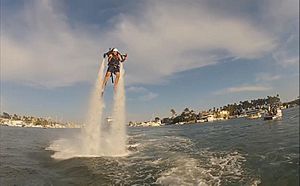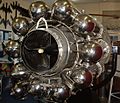Jet engine facts for kids
A jet engine is a powerful machine that helps planes fly! It works by sucking in air, squeezing it, mixing it with fuel, and then burning it. This creates a super-hot blast of gas that shoots out the back, pushing the engine and the plane forward. It's like a continuous explosion happening inside.
This push is called thrust. Jet engines are great because they can make planes go very fast, especially high up in the sky. While propellers push a lot of air a little bit, jet engines push a little air a lot! The way they work is similar to how a car engine works, but it happens all the time, not in separate steps.
Jet engines are very good at high speeds, even faster than the speed of sound! They also work well at high altitudes where the air is thin. For slower planes, you might see a propeller powered by a gas turbine. These are called turboprops. Very small planes usually use regular piston engines to spin their propellers.
Contents
What Jet Engines Are Used For
Jet engines are super versatile! They power many things that fly:
- Jet aircraft: Like the big passenger planes you see in the sky.
- Cruise missiles: These are uncrewed flying weapons.
- Unmanned aerial vehicles (UAVs): Also known as drones.
In the form of rocket engines, they also power:
- Fireworks
- Model rockets
- Spaceflight (sending rockets into space)
- Military missiles
Jet engines aren't just for flying! They've also been used to make cars go incredibly fast. The car that holds the land speed record, called ThrustSSC, is powered by a jet engine.
Sometimes, jet engines are changed a bit to be used for other things. They can become industrial gas turbines or marine powerplants. These are used to:
- Generate electricity in power plants.
- Power pumps for water, natural gas, or oil.
- Help propel large ships and trains.
Some jet engine designs are also used to create turboshaft and turboprop engines. These types of engines are often found in helicopters and some propeller-driven planes.
Different Kinds of Jet Engines
There are many types of jet engines, but they all create forward push using the idea of jet propulsion. Here are some of the main types:
Turbojet Engines
A turbojet is a common type of jet engine. It's known for its simple design. However, because it's so basic, it doesn't have some of the newer improvements found in other engines.
Ramjet Engines
A ramjet is special because it doesn't have moving parts like compressor blades. Instead, it uses the speed of the air rushing into the engine to compress it. This makes them very simple, but they need to be going very fast already to work.
Scramjet Engines
A scramjet is like a super-fast ramjet. The air rushing in is compressed but never slows down below supersonic speeds (faster than sound). The whole process of air intake, burning fuel, and exhaust happens in one special tube. These engines can go at incredibly high speeds, but they are very hard to design and build.
Turboprop Engines
A turboprop engine uses a jet turbine to spin a propeller. It's very efficient, meaning it uses fuel well. However, it can't go as fast as a pure jet engine and can be a bit noisy.
Propfan Engines
A propfan engine is similar to a turboprop, where a jet engine spins a propeller. But unlike a turboprop, it doesn't have a duct around the propeller. These engines are quite noisy and aren't used much anymore.
Pulsejet Engines
A pulsejet is a very simple engine. Air enters a tube, the front closes, fuel burns, and exhaust shoots out the back. This happens in quick pulses. They are very simple and often used in model aircraft, but they are noisy and not very efficient. Their parts also wear out quickly.
Pulse Detonation Engines
This engine is like a pulsejet, but the fuel burns in a super-fast explosion called a detonation. In theory, these engines could be super efficient. However, they are extremely noisy, their parts wear out very fast, and it's hard to get the explosion to start.
Turborocket Engines
A turborocket engine adds an extra chemical, like oxygen, to the air stream. This helps the engine work at very high altitudes. They can operate over a wide range of altitudes and speeds, but carrying extra chemicals like liquid oxygen can be dangerous.
Images for kids
-
U.S. Air Force F-15E Strike Eagles
-
Jet engine during take-off showing visible hot exhaust (Germanwings Airbus A319)
-
Gloster Meteor F.3s. The Gloster Meteor was the first British jet fighter and the Allies' only jet aircraft to achieve combat operations during World War II.
-
Specific impulse as a function of speed for different jet types with kerosene fuel (hydrogen Isp would be about twice as high). Although efficiency plummets with speed, greater distances are covered. Efficiency per unit distance (per km or mile) is roughly independent of speed for jet engines as a group; however, airframes become inefficient at supersonic speeds.
See also
 In Spanish: Motor de reacción para niños
In Spanish: Motor de reacción para niños













